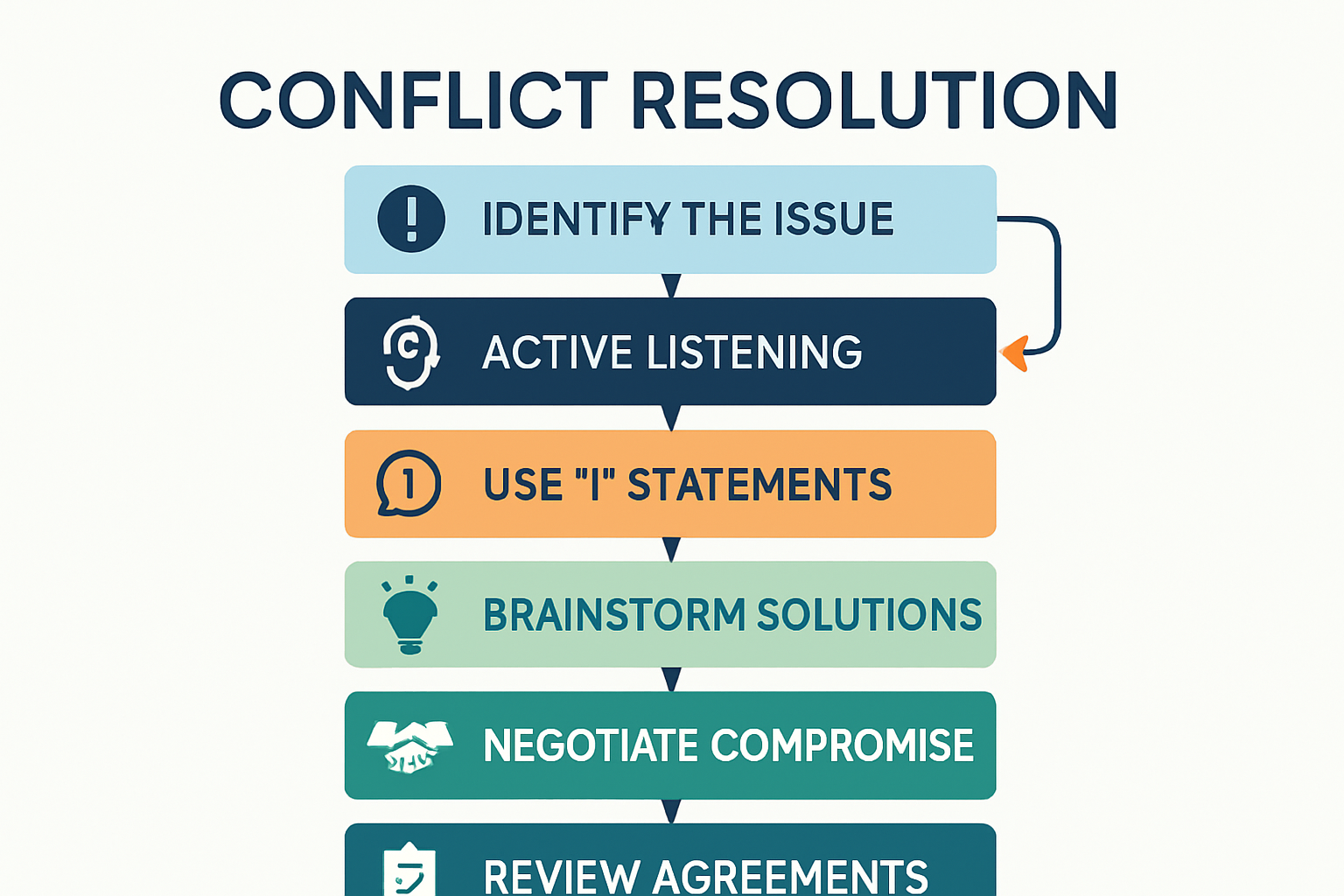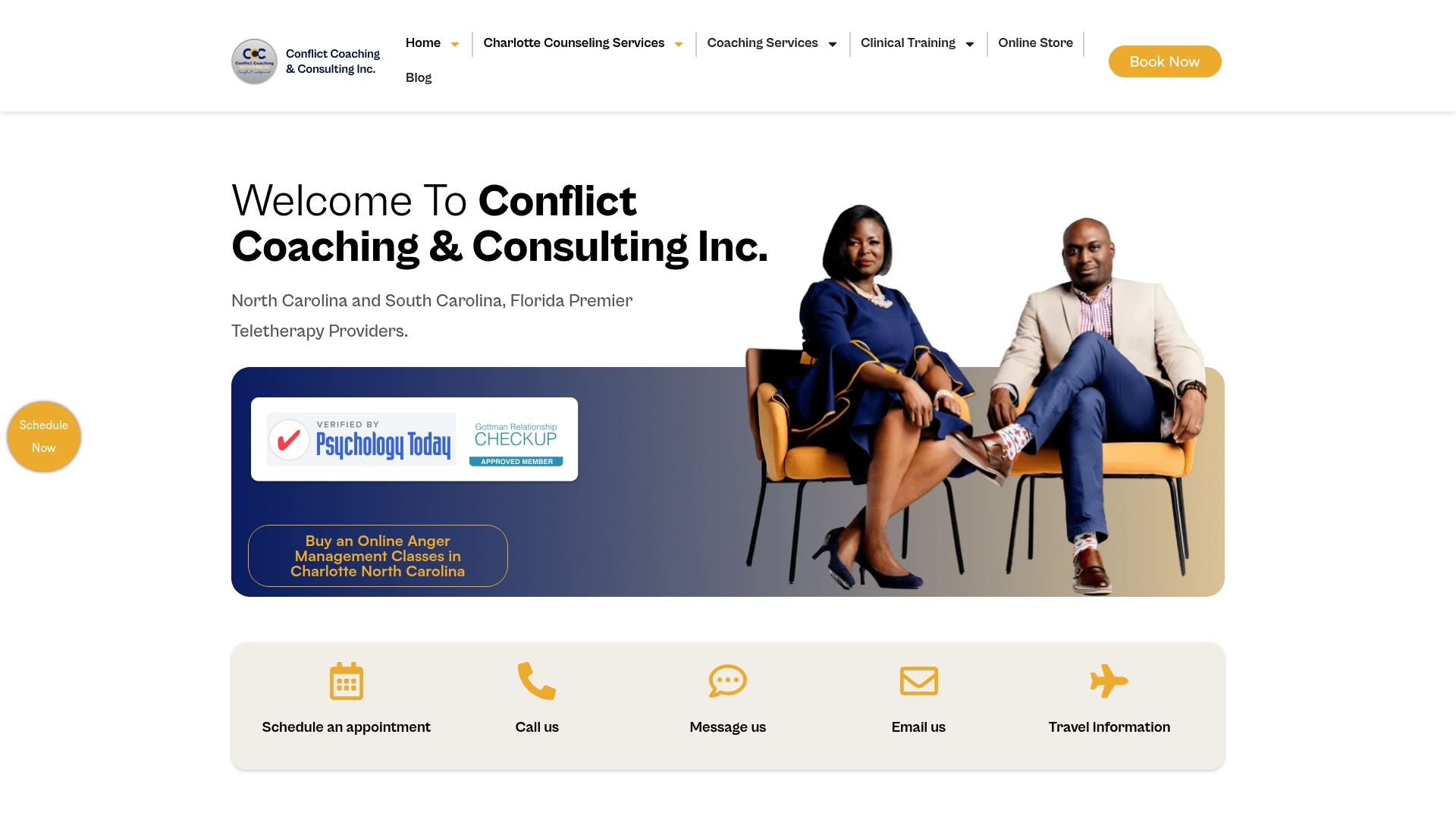Effective Conflict Resolution Steps for Couples, Families, and Professionals 2025

Arguments can shake even the closest families or strongest teams, and almost everyone gets pulled into conflict at some point. While heated words and misunderstandings feel impossible to solve, research shows that active listening alone can improve conflict resolution by as much as 40 percent, making a bigger difference than most realize. But the catch is that the most effective steps do not come naturally, and some of the best results actually come from counterintuitive moves you may never expect.
Table of Contents
- Understanding Key Conflict Resolution Steps
- Applying Steps In Families And Relationships
- Culturally Responsive Conflict Resolution Strategies
- Teletherapy Options For Conflict Resolution
Quick Summary
| Takeaway | Explanation |
|---|---|
| Active listening is essential. | Fully concentrate on what others say to foster understanding and resolve conflicts. |
| Use ‘I’ statements to express feelings. | This communicates emotions without blaming others, avoiding escalation during discussions. |
| Collaborative problem-solving enhances relationships. | Involve all parties in generating solutions to ensure everyone’s needs are met. |
| Emotional regulation improves conflict outcomes. | Manage personal emotions and take breaks to maintain calm during conflicts, promoting constructive dialogue. |
| Cultural sensitivity impacts resolution strategies. | Acknowledge diverse backgrounds to tailor conflict management approaches according to individual communication styles. |
Understanding Key Conflict Resolution Steps
Conflict is an inevitable part of human interaction, whether in personal relationships, professional environments, or family dynamics. Understanding effective conflict resolution steps is crucial for maintaining healthy relationships and creating positive outcomes. The ability to navigate disagreements constructively can transform potentially destructive interactions into opportunities for growth and mutual understanding.
The Foundation of Effective Communication
Successful conflict resolution begins with communication that goes beyond simply talking. According to National University, active listening is the cornerstone of resolving conflicts. This means fully concentrating on what the other person is saying, understanding their perspective, and responding thoughtfully rather than reactively.
Key communication strategies include:
- Asking Open-Ended Questions: Encourage deeper dialogue by asking questions that require more than yes or no answers.
- Practicing Empathy: Try to understand the emotions and underlying concerns behind the other person’s position.
- Maintaining Respectful Tone: Use a calm and neutral voice, even when emotions are running high.
Strategic Approach to Conflict Management
Iowa State University Extension and Outreach emphasizes that conflict, when managed properly, can be a constructive force. The key is developing a systematic approach to addressing disagreements. This involves creating a safe space for dialogue, identifying the root cause of the conflict, and working collaboratively towards a mutually acceptable solution.
Professionals and individuals can benefit from a structured conflict resolution process that includes:
- Identifying the specific issue
- Listening to all perspectives
- Brainstorming potential solutions
- Negotiating a compromise
- Implementing and reviewing the agreed-upon solution

The following table summarizes the key steps of a structured conflict resolution process as outlined in this section:
| Step | Description |
|---|---|
| Identify the issue | Clearly define the conflict at hand |
| Listen to all perspectives | Ensure everyone involved shares their viewpoint |
| Brainstorm solutions | Generate multiple possible ways to resolve the issue |
| Negotiate a compromise | Work together to find an acceptable solution for everyone |
| Implement and review | Put the solution into action and assess effectiveness |
Emotional Regulation and Conflict Resolution
Emotional intelligence plays a critical role in resolving conflicts effectively. This requires self-awareness, the ability to manage personal emotions, and understanding the emotional landscape of the conflict. Taking strategic timeouts during heated discussions can prevent escalation and provide space for reflection.
Learn more about our comprehensive conflict resolution strategies that can help you navigate complex interpersonal challenges with confidence and empathy. By developing these skills, individuals can transform potential confrontations into opportunities for deeper understanding and stronger relationships.
Applying Steps in Families and Relationships
Resolving conflicts within families and relationships requires specialized strategies that prioritize emotional connection and mutual understanding. While general conflict resolution principles apply, family dynamics demand a more nuanced and compassionate approach that preserves relationships and promotes long-term harmony.
Communication Strategies for Family Conflict Resolution
The Ohio State University Extension highlights the critical importance of defining conflicts clearly and focusing on specific behaviors rather than attacking individuals. This approach helps prevent emotional escalation and creates a constructive environment for problem-solving. Family members can implement specific communication techniques to navigate disagreements effectively:
- Using ‘I’ Statements: Express feelings and concerns without blaming or accusing. For example, “I feel frustrated when” instead of “You always…”
- Active Listening: Demonstrate genuine engagement by reflecting back what you’ve heard and seeking clarification
- Emotional Validation: Acknowledge each family member’s feelings, even if you disagree with their perspective
Collaborative Problem-Solving in Relationships
The Raising Children Network recommends a systematic approach to resolving relationship conflicts. This involves rephrasing statements to ensure mutual understanding and avoiding generalizations that can create defensiveness. The key is to focus on one issue at a time and collaboratively brainstorm solutions that consider everyone’s needs.
Critical steps in this process include:
- Identifying the specific conflict
- Allowing each person to share their perspective
- Generating multiple potential solutions
- Negotiating a mutually acceptable resolution
- Implementing and reviewing the agreed strategy
Professional Support and Emotional Regulation
The Better Health Channel emphasizes the importance of staying calm and maintaining respectful communication during conflicts. When family tensions become challenging to manage independently, seeking professional guidance can provide valuable insights and mediation strategies.
Emotional regulation plays a crucial role in effective conflict resolution. This involves:
- Recognizing and managing personal emotional triggers
- Taking strategic breaks during intense discussions
- Practicing self-awareness and empathy
- Maintaining a solution-oriented mindset
For those seeking deeper insights into navigating complex family dynamics, explore our comprehensive guide to family conflict resolution. By developing these skills, families can transform potential conflicts into opportunities for growth, understanding, and stronger relationships.
Culturally Responsive Conflict Resolution Strategies
Conflict resolution is not a one-size-fits-all approach. Cultural background, personal experiences, and social contexts significantly influence how individuals perceive, communicate, and resolve conflicts. Understanding and respecting these cultural nuances is essential for developing effective and empathetic conflict resolution strategies that honor diverse perspectives and communication styles.
Cultural Dimensions of Conflict Interpretation
Research on Mexican-origin couples reveals fascinating insights into how cultural orientations shape conflict resolution approaches. Different cultural backgrounds can dramatically impact communication strategies, with some cultures preferring direct confrontation while others emphasize non-confrontational, harmony-preserving methods.
Key cultural considerations in conflict resolution include:
- Communication Styles: Understanding variations in verbal and non-verbal communication
- Power Dynamics: Recognizing how cultural hierarchies influence interaction
- Emotional Expression: Acknowledging diverse ways of processing and expressing emotions
Professional Approaches to Cultural Competence
Family dispute resolution professionals emphasize the importance of collaborative conversations and continuous learning about cultural differences. This approach requires professionals to:
- Engage in ongoing cultural education
- Practice active and empathetic listening
- Challenge personal biases and assumptions
- Develop flexible communication strategies
Professionals must move beyond surface-level understanding and develop deep, nuanced insights into how cultural backgrounds shape conflict perceptions and resolution strategies.
Transformative Community Conflict Resolution
The Community Tool Box highlights the significance of acknowledging systemic injustices and committed social change in conflict resolution. This approach recognizes that conflicts often stem from broader societal inequalities and power imbalances.
Strategies for transformative conflict resolution include:
- Recognizing historical and systemic contexts
- Creating safe spaces for dialogue
- Promoting mutual understanding
- Addressing root causes of conflicts
Learn more about our comprehensive conflict resolution strategies that prioritize cultural sensitivity and individual experiences. By embracing these nuanced approaches, we can build more inclusive, respectful, and effective conflict resolution frameworks that celebrate diversity and promote genuine understanding.
Teletherapy Options for Conflict Resolution
Teletherapy has emerged as a transformative approach to conflict resolution, offering unprecedented accessibility and flexibility for individuals, couples, and families seeking professional support. The digital landscape of mental health services has expanded dramatically, providing innovative solutions that bridge geographical barriers and accommodate diverse scheduling needs.
Technological Adaptations in Conflict Resolution
Research published in the Journal of Marital and Family Therapy reveals the complex dynamics of teletherapy for couples and families. Therapists must develop specialized skills to effectively navigate virtual communication, including adapting verbal and non-verbal communication techniques to compensate for limited physical interaction.
Key technological considerations for effective teletherapy include:
- Secure Video Platforms: Ensuring confidentiality and privacy
- Interactive Communication Tools: Using screen sharing and digital whiteboards
- Robust Internet Connectivity: Maintaining stable communication channels
- Digital Assessment Resources: Implementing online questionnaires and diagnostic tools
Below is a summary table of key technological considerations for teletherapy conflict resolution:
| Technological Aspect | Purpose/Benefit |
|---|---|
| Secure Video Platforms | Protect privacy and ensure confidentiality |
| Interactive Communication Tools | Enhance engagement with digital features |
| Robust Internet Connectivity | Ensure smooth, interruption-free sessions |
| Digital Assessment Resources | Efficiently gather and analyze client data |
Professional Challenges and Adaptation Strategies
Researchers exploring telemental health interventions highlight the unique challenges professionals face when delivering conflict resolution services online. Therapists must prepare additional materials, remain exceptionally flexible, and develop innovative techniques to de-escalate conflicts and facilitate meaningful conversations in a virtual environment.
Strategic adaptation strategies for teletherapy include:
- Developing enhanced verbal communication skills
- Creating structured digital interaction protocols
- Implementing comprehensive pre-session preparation
- Designing specialized online intervention techniques
Ethical Considerations and Accessibility
The Family Journal’s comprehensive review emphasizes that teletherapy increases service accessibility while reducing traditional barriers such as geographical limitations and scheduling constraints. However, professionals must carefully navigate ethical considerations, including maintaining client confidentiality, managing technological interruptions, and ensuring the therapeutic effectiveness of online interventions.
Teletherapy offers significant benefits, particularly for:
- Individuals with mobility challenges
- People in rural or underserved communities
- Clients with demanding work schedules
- Individuals experiencing transportation difficulties
Explore our comprehensive teletherapy conflict resolution options to discover how digital platforms can transform your approach to resolving interpersonal challenges. As technology continues to evolve, teletherapy represents a powerful, flexible, and increasingly sophisticated approach to supporting individuals and families through complex emotional landscapes.

Frequently Asked Questions
What are the key steps in effective conflict resolution?
Effective conflict resolution involves several key steps: identifying the issue, listening to all perspectives, brainstorming potential solutions, negotiating a compromise, and implementing and reviewing the agreed-upon solution. This structured approach helps in addressing disagreements constructively.
How does active listening improve conflict resolution?
Active listening enhances conflict resolution by fostering understanding. It requires fully concentrating on what the other person is saying, which can improve outcomes by as much as 40%. This approach encourages empathy and reduces the chances of escalation.
What role does emotional regulation play in resolving conflicts?
Emotional regulation is crucial in conflict resolution as it helps individuals manage their emotions during heated discussions. It involves self-awareness and the ability to take breaks when necessary, promoting calmer, more constructive dialogues.
Why is it important to consider cultural differences in conflict resolution?
Considering cultural differences in conflict resolution is essential as communication styles, power dynamics, and emotional expressions can vary across cultures. Acknowledging these differences allows for more tailored and effective conflict management strategies that respect individual backgrounds.
Turn Conflict Into Growth With Mastering Conflict
Are you struggling to manage heated arguments, emotional escalations, or repeated misunderstandings in your relationships or family? The article outlined how active listening, emotional regulation, and collaborative problem-solving can transform conflict into an opportunity for deeper connection, but these strategies often require expert guidance to truly work in real life.

Let our licensed counselors help you put these powerful techniques into practice. Whether you need anger management, specialized couples counseling, or support with family tensions, Mastering Conflict offers effective, evidence-based services designed for real-world solutions. Discover more about our personalized conflict resolution and mental health programs by visiting our online therapy options. Take the first step today—stronger relationships and a calmer home are possible when you act now.
Recommended
- Conflict Resolution for Families: Tools, Tips, and Teletherapy 2025 – Mastering Conflict
- What Is Conflict Resolution? Key Strategies for 2025 – Mastering Conflict
- Conflict Resolution for Couples: Practical Strategies for 2025 – Mastering Conflict
- How to Deal With Parenting Conflicts
- Understanding Weaponized Incompetence in Relationships – Plentiful

7 Responses